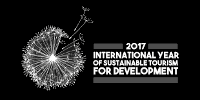The Future of...Plastic Pollution Free: Garbology in the Galapagos
/At the World Travel Market 2019 in London, I listened with fascination to The Galapagos Conservation Trust case study on ‘garbology’ - how they are studying garbage flows in the ocean. It seems such a logical way to better manage plastic pollution, not just for clean-ups, but to understand for better prevention in the future.
With thanks to Andy Donnelly.
Galapagos, the birthplace of Charles Darwin’s theory of evolution and the world’s first UNESCO World Heritage Site listed for Natural Values, is unlike anywhere else on Earth. This remarkable history combined with its reputation for incredible wildlife experiences makes the top of most ecotourists’ lists around the world.
This reputation still holds true, with 80% of the land birds, 97% of the reptiles and land mammals and 20% of the marine species in Galapagos not found anywhere else in the world.
However, Galapagos is not immune to the accelerating rate of species extinction worldwide with recent figures showing that over 80 of the Islands’ species are now listed as critically endangered or endangered on the IUCN Red List of Threatened Species.
Heading up the Flagship Programmes at the Galapagos Conservation Trust (GCT), the team and I support and drive critical habitat and species conservation work needed in response to key threats facing the Islands.
Much of this is at the forefront of conservation science, working with international experts that are pushing the boundaries of what we thought was possible.
One of our flagship programmes, Plastic Pollution Free Galapagos, aims to tackle one of the most pressing issues facing island ecosystems around the world today, marine plastic.
While Galapagos remains one of the most pristine environments in the world, it is not immune to this problem; in fact, it is more vulnerable due to the number of high risk endemic species found there.
At least 18 different species in Galapagos have been recorded either entangled by plastic, or have been found to have ingested it, posing a new threat to the unique biodiversity of the Islands. It is no exaggeration to say that Galapagos is under siege from marine plastic pollution.
But there is hope. Real hope. Due to a number of factors including geographical location, Galapagos is now best placed in the world to show how a marine reserve can tackle plastic pollution in our oceans according to expert scientists.
At GCT, we are coordinating a partnership of international, multi-disciplinary team of experts from the fields of oceanography, marine biology, eco-toxicology, environmental psychology and even archaeology to combine ground-breaking scientific research with education and outreach.
There’s a strong belief that by supporting the efforts of the Galapagos National Park authority with cutting-edge science and working closely with local NGOs, the local community and research organisations like the Charles Darwin Research Station and the Galapagos Science Centre, together we have a genuine chance to make ‘The Enchanted Isles” plastic pollution free once again.
Part of the Plastic Pollution Free Galapagos programme involves ‘garbology’, a new field of science using archaeological methods to analyse the life history of plastic items that wash up in Galapagos to understand where it originated.
This research, combined with novel oceanographic model technology, allows us to map how ocean currents are transporting the plastic to the Islands and from where.
This helps us to identify where further community outreach is needed and we now know that the majority of plastic that comes from mainland South America probably only comes from a narrow area of coastal Southern Ecuador and Northern Peru.
However, there’s a strong indication that significant plastic pollution reaching Galapagos shores originates from international fishing operations outside the Ecuadorian border of the Galapagos Marine Reserve, raising questions about waste management practice on these industrial fleets.
Clean-ups are an essential way of removing plastic from the Galapagos ecosystem, particularly if the focus is on the primary beaches where the pollution arrives. Each year, The Galapagos National Park authority leads a series of beach clean-up expeditions supported by Conservation International and GCT.
The team heads to remote islands surveying and cleaning up with the collected plastic then analysed by a team of dedicated local volunteers.
Plastic samples collected are then used in Garbology investigations to study the plastic’s origins, supported by the Archaeology department at the University of York.
Ongoing community and schools campaigns are undertaken alongside the beach clean-ups to involve the Galapagos community and help spread the message of responsible plastic use.
The next stage of oceanography research is to develop another model to predict how the plastic moves within the Galapagos Marine Reserve once it has arrived, helping focus beach clean-up efforts.
We intend for this technology to be used in the future by other archipelagos suffering from plastic pollution problems.
The sooner the pollution can be removed, the lower the threat it poses to wildlife and the less likely it is to breakdown into microplastic and become part of the ecosystem forever.
The tourism industry has an important part to play.
With more than 275,000 visitors to the islands annually we need to consider the plastic as well as carbon footprint this represents. Travelling responsibly and saying no to single use plastics (SUPs) at every stage of the journey can be hugely influential.
Isn’t it time airlines and airports looked at their role in this? At a workshop with the Latin American Tourist Association last year we quickly showed that the journey to Galapagos has the highest rates of SUP usage across the entire holiday. Without our support we risk losing the iconic wildlife that makes The Archipelago the pinnacle of ecotourism destinations.
If we can’t save Galapagos, where can be saved?
Plastic Pollution Free Galapagos is a £4.5 million pound programme, with Galapagos Conservation Trust aiming to raise £1.5m over the next three years to create real change in the Galapagos ecosystem and community. The charity, rely on the generosity of donors in the UK and abroad to raise money to support their work to preserve Galapagos for generations to come. To find out more about their programmes and to donate, visit: galapagosconservation.org.uk





















